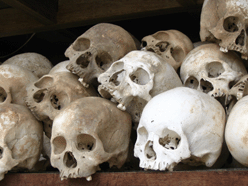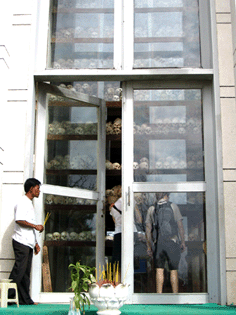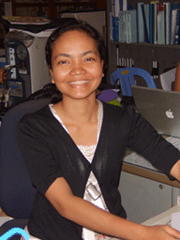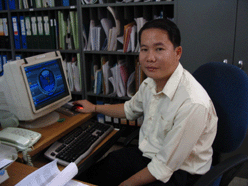 "History is written by those who can write it. It is difficult to believe the writer, because everyone has their own interests; the writer is not independent. Sometimes it is very complicated for me to believe." – Nou Va, age 28, Phnom Penh, Cambodia, about the history of the Khmer Rouge
"History is written by those who can write it. It is difficult to believe the writer, because everyone has their own interests; the writer is not independent. Sometimes it is very complicated for me to believe." – Nou Va, age 28, Phnom Penh, Cambodia, about the history of the Khmer Rouge
We sat around the breakfast table gently sweating along with our hosts in the early morning heat. Tola (1) served porridge for the guests, then put a big scoop of rice in her own bowl before adding the soup. "In Pol Pot times, we only had gruel to eat. Now, I have to add rice so it won’t taste the same." Her husband quickly chastised her for speaking of such a thing in front of guests. I looked down at the brimming bowl and thought about sensory memory: this woman’s taste buds can recall pain in ways she has suppressed in her mind. A diamond ring glitters on her finger as Tola scoops the rice up to her mouth. As a young woman, Tola lived under the Khmer Rouge regime; now she is a retired nurse with a husband high in government. Life is comfortable, yet every morning she puts that rice in her bowl before the soup. The legacy of trauma persists in the Royal Kingdom of Cambodia.
This small country tucked between the borders of Vietnam, Thailand, and Myanmar does not have a gentle past. In the last half century its people have experienced violence from many sources: the US bombing of villages during the Vietnam/American war (1965-1973), (2) the civil war between US-backed Lon Nol supporters and communist insurgents (1970-1975); and the period of Democratic Kampuchea, (1975-1979) when more than a million Cambodians – at least one of every eight citizens – died from starvation, overwork or execution (3) under the Khmer Rouge regime.(4) Idealistic rural teenagers armed with machine guns were the foot-soldiers, while the leadership of this brutal regime was comprised of former school teachers who saw forced revolution as the only antidote to US imperialism. Yet the impact of their agenda of gender and age-divided collective living and slave-like labor continues long after their overthrow by the Vietnamese in 1979 and throughout the Vietnamese occupation, ending in 1989.
 Fighting continued between the government and Khmer Rouge sympathizers until the conflicting factions signed the Paris Peace Accords in 1991. However, more was needed to maintain the ceasefire. Cambodia then earned the dubious distinction of being administered by the United Nations Transitional Authority (UNTAC) from March 1992 until September 1993, at which point Prince Norodom Sihanouk accepted the newly designed Constitution, became king once again, and UNTAC-administered elections were held. (5) The King’s party, the United Front for an Independent, Neutral, Peaceful, and Co-operative Cambodia (FUCINPEC), and the Sam Rainsy Party are the current opposition parties to the ruling Cambodia People’s Party (CPP), which was supported by Vietnam and maintains a Communist undertone, incorporating many former Khmer Rouge members and sympathizers. However, after current Prime Minister and CPP party member Hun Sen’s bloody coup to oust his FUNCINPEC co-Prime Minister in 1997, the illusion of democracy broke down.(6) Despite the reported ‘free and fair’ elections in 1998 and 2002, (7) Cambodian democracy still has a long road ahead.
Fighting continued between the government and Khmer Rouge sympathizers until the conflicting factions signed the Paris Peace Accords in 1991. However, more was needed to maintain the ceasefire. Cambodia then earned the dubious distinction of being administered by the United Nations Transitional Authority (UNTAC) from March 1992 until September 1993, at which point Prince Norodom Sihanouk accepted the newly designed Constitution, became king once again, and UNTAC-administered elections were held. (5) The King’s party, the United Front for an Independent, Neutral, Peaceful, and Co-operative Cambodia (FUCINPEC), and the Sam Rainsy Party are the current opposition parties to the ruling Cambodia People’s Party (CPP), which was supported by Vietnam and maintains a Communist undertone, incorporating many former Khmer Rouge members and sympathizers. However, after current Prime Minister and CPP party member Hun Sen’s bloody coup to oust his FUNCINPEC co-Prime Minister in 1997, the illusion of democracy broke down.(6) Despite the reported ‘free and fair’ elections in 1998 and 2002, (7) Cambodian democracy still has a long road ahead.
Creating the Tribunal
 A combination of political party motivation, international investor histories (specifically China), and financial constraints within Cambodia have significantly delayed the creation of a tribunal to prosecute former Khmer Rouge officials. It was a long and arduous process to finally reach an agreement between the Cambodian government and the international community on the make-up and structure of the Khmer Rouge tribunal. Cambodia asked for UN assistance in 1997 to establish a tribunal, but the negotiations continued on and off for several years, and even broke down in 2002 over the ratio of international and Cambodian judges. However, a 2001 Cambodian law and a 2003 agreement between Cambodia and the United Nations paved the way for the National Assembly of Cambodia to create the Extraordinary Court Chambers of Cambodia (ECCC) in 2004. (8) Judges were named to the ECCC in 2006, but as of this writing, the court has not yet approved internal rules, meaning that they cannot start hearing evidence.
A combination of political party motivation, international investor histories (specifically China), and financial constraints within Cambodia have significantly delayed the creation of a tribunal to prosecute former Khmer Rouge officials. It was a long and arduous process to finally reach an agreement between the Cambodian government and the international community on the make-up and structure of the Khmer Rouge tribunal. Cambodia asked for UN assistance in 1997 to establish a tribunal, but the negotiations continued on and off for several years, and even broke down in 2002 over the ratio of international and Cambodian judges. However, a 2001 Cambodian law and a 2003 agreement between Cambodia and the United Nations paved the way for the National Assembly of Cambodia to create the Extraordinary Court Chambers of Cambodia (ECCC) in 2004. (8) Judges were named to the ECCC in 2006, but as of this writing, the court has not yet approved internal rules, meaning that they cannot start hearing evidence.
Why this hold-up in the process? First, there are so many high-ranking government officials that served in the Khmer Rouge in the late 1970s, and these officials are nervous that their name might appear on the list of people to be tried by the court. Therefore, they stall the process. Second, China – with major investments in Cambodia – does not want to see a precedent set for over-zealous former communist governments being the focus of international tribunals. Lastly, the court has not received sufficient funds to operate as it is structured.
The ECCC is charged with prosecuting living Khmer Rouge leaders with crimes against humanity and/or genocide. It is speculated that among those to be tried are former army chief Ta Mok, and chief interrogator Kaing Khek Iev. It is not clear whether other leaders, such as past head of state Khieu Samphan, then-foreign minister Ieng Sary, and Nuon Chea, known as "Brother Number Two" will be tried, despite heavy criticism from human rights groups.(9)
A group of United Nations legal experts specifically recommended against a hybrid or local tribunal in Cambodia mainly because of a lack of judicial independence and capacity.(10) However, the court does have a mixed, or ‘hybrid’ structure wherein the judges are a mix of locals and internationals while the legal procedures draw from both international and national sources. The hybrid tribunal is becoming popular internationally – in part due to the huge costs of running a purely international tribunal – with recent hybrid courts established in Sierra Leone and East Timor. A compromise was pushed by the United States government to ensure that in the ECCC at least one international judge must agree with any decision, perhaps in recognition of the political and personal influences placed upon Cambodian judges. Unfortunately, there is little provision for what to do in the case of a stalemate between the judges, and the specific structure of the hybrid court has raised serious questions from the international community. Kofi Annan expressed in 2003 that he would "have much preferred that the draft agreement provide for both of the Extraordinary Chambers to be composed of a majority of international judges."(11)
Although the framework of the court is in place, with Cambodian judges holding majority power in the court, doubt abounds as to the potential for a tribunal to really bring a sense of justice to Cambodia. Yet, the general consensus is that it is worth a try. "Justice cannot take place 100% of the time," explains 28 year old Va Nou, "even so, it’s better to send the leaders to trial and jail."
Justice and reconciliation in Cambodia face more than just legal challenges. The telling of history by survivors of the Khmer Rouge regime to their children has not been well-received. In a country which has more than 35% of its citizens under the age of 15, many children do not believe the suffering their parents describe because it is too hard for them to imagine that Khmers could kill other Khmers.(12) Furthermore, the Royal Government of Cambodia has not yet reached a decision about which version of history is appropriate to teach school children.(13) As recently as 2001, a new section on the Khmer Rouge events was added to 12th grade social science texts but the book was recalled by the Cambodian national government and released without the Khmer Rouge section.(14) The perpetual revising and recalling of texts adds to the confusion for youth about what they should believe, and this has led to a dangerous loss of memory in the collective Cambodian context.
Youth Outreach Through Film
To address the trend of children discrediting their parents’ history, an outreach project is underway at the Khmer Institute of Democracy (KID). With support from the Open Society Justice Initiative, based in New York, the Khmer Rouge Tribunal project at KID has focused on educating the public on the upcoming trial. Implemented by a team of dynamic Cambodian staff, the project has made flip charts to facilitate presentations about the court in the low literacy rural areas, as well as a highly acclaimed video targeting young people who struggle to come to terms with Cambodian history.
 Vicchra Muoyly, a Program Officer responsible for the project, explains that while doing outreach activities, "we kept hearing from parents that their children did not believe their story. The kids say, ‘This is the story that you make up. Parents are making this up when I do something bad. We need to see proof.’ So, we decided to make a film called Seeing Proof." The film has been shown to groups as large as 1,000 people in the provinces, and is being distributed to networks of community volunteers and village leaders. The most powerful part of the film follows a young man who refused to believe his mother’s stories about the Khmer Rouge as he visits a stupa (Buddhist holy site) with a collection of several hundred skeletal remains unearthed from near-by mass graves. Once he saw the site, his attitude and entire conception of who his mother is transformed. Most young people in Cambodia do not have a frame of reference for the atrocities committed under the Khmer Rouge. It seems impossible to them that, for example, 100 people survived on two cups of rice. In fact, many people did not survive at all.
Vicchra Muoyly, a Program Officer responsible for the project, explains that while doing outreach activities, "we kept hearing from parents that their children did not believe their story. The kids say, ‘This is the story that you make up. Parents are making this up when I do something bad. We need to see proof.’ So, we decided to make a film called Seeing Proof." The film has been shown to groups as large as 1,000 people in the provinces, and is being distributed to networks of community volunteers and village leaders. The most powerful part of the film follows a young man who refused to believe his mother’s stories about the Khmer Rouge as he visits a stupa (Buddhist holy site) with a collection of several hundred skeletal remains unearthed from near-by mass graves. Once he saw the site, his attitude and entire conception of who his mother is transformed. Most young people in Cambodia do not have a frame of reference for the atrocities committed under the Khmer Rouge. It seems impossible to them that, for example, 100 people survived on two cups of rice. In fact, many people did not survive at all.
Working on this type of project has been transformative for the Cambodian staff members, as well. Growing up, the Program Officers Vicchra, Va, and Chantra also had doubts about their parents’ stories of what had happened under the Khmer Rouge. "At first, it was hard to believe my parents because most of what they told me what unbelievable. But after I worked at KID, meeting survivors and perpetrators, I believed," reflected Chantra Chou, Program Officer. In regards to the Khmer Rouge, Chantra commented that "everyone has cleaned their hands and said, ‘I was not responsible.’ Day by day, thinking about the Khmer Rouge, I still have 1,000 questions in my head to be answered."
But will these questions be answered with the ECCC? "Sometimes, I think the ECCC is just a symbol of impunity elimination because they [will] just convict high-ranking leaders, not all responsible," explained Va Nou, Program Officer. However, as a law school graduate, Va is committed to doing outreach and education about how the ECCC works and how citizens can participate. The justice-seeking mechanisms in Cambodia are imperfect, but they are perceived as being better than nothing. Therefore, people like Va, Chantra and Vichhra are working to promote the workings of the court.
No matter what direction the ECCC takes, it is clear that the destruction wrought by the Khmer Rouge continues to have a ripple effect. As Vichhra explained, "I am also a victim of the Khmer Rouge. I was not alive at that time, but if the Khmer Rouge had not been here, my country, my studies, and my life would be better. They killed all the older people, and I could have learned so much from them. I feel really, really sorry that this happened."
Reconciliation or A Waste of Money?
Today the older generation who survived the Khmer Rouge genocide remains shell-shocked, whether in the extended diaspora in Southern California, or persevering often near the same rice fields where they were forced to farm by Khmer Rouge comrades. Many elders refuse to rehash history because of the nightmares it unleashes, but others feel the need to pass their stories on to their children in hope of preventing future violence.(15) Those that do try to tell their stories find resistance at every level. Current Prime Minister Hun Sen has fostered a culture of impunity (16) by pardoning several top level former Khmer Rouge leaders and appointing them to national government posts. The lack of punishment for Khmer Rouge leaders has set a precedent for this culture of impunity in contemporary Cambodia. History, the essential memory-keeper of society, is then perceived as unjust by the grassroots when a culture of impunity is modeled by leaders (Lambourne 2004: 5).
There is also considerable debate about whether a tribunal at this point will facilitate reconciliation, or whether a truth and reconciliation commission or other community based survivors’ forum would be more effective in relieving past trauma.(17) It is critical for national reconciliation to take place in some manner so that lessons from the past can be incorporated into the collective Cambodian conscious. The success of the Khmer Rouge Tribunal has yet to be seen, but the outreach around it, spearheaded by committed young Cambodians like Vicchra, Va, and Chantra is undoubtedly prompting conversations between family members and neighbors that otherwise would not have been spoken. Vicchra’s experience is a case in point: "When I talk now to my father, I say, ‘I am so sorry. I did not believe your story. Now I believe you.’"
###
For more information about the Khmer Rouge Tribunal, please visit http://www.khmerrough.com
and www.krtrial.info
Khmer Institute of Democracy homepage: http://www.bigpond.com.kh/users/kid/index.htm
Mneesha Gellman and Josh Dankoff are interns at the Khmer Institute of Democracy in Phnom Penh, Cambodia. Mneesha is doing a Masters in International Peace and Conflict Studies and Josh is doing a Masters of Development Practice, both at the University of Queensland in Brisbane, Australia. They can be contacted at Mneesha (at) gmail.com or jadankoff (at) gmail.com
All photos by Mneesha Gellman
Notes:
1. The name of this Cambodian woman I spoke with has been changed to protect her privacy.
2. These years indicate the time that the US had ground troops committed in Vietnam. However, bombing of the Cambodian countryside began when the Nixon Administration secretly ordered "Operation Breakfast" on March 18, 1969. In total, the US dropped an estimated 540,000 tons of bombs in Cambodia, killing anywhere from 150,000 to 500,000 civilians (PBS 2002). Unexploded ordinance continues to be found, often by children who are then maimed in the consequent explosion. There is also evidence, fiercely denied by Nixon’s Administration, that US bombing aided the Khmer Rouge recruitment process. Former New York Times correspondent Sydney Schanberg said the Khmer Rouge "… would point… at the bombs falling from B-52s as something they had to oppose if they were going to have freedom" (PBS 2002).
3. (Chandler 1991: 1) from Chandler, David P. 1991. The Tragedy of Cambodian History: Politics, War, and Revolution since 1945. New Haven: Yale University Press.
4. Cambodia scholar David Chandler describes the Khmer Rouge as utilizing Mao Zedong-influenced socialist ideology (1991: 148). There is not agreement about the exact number of those that died in the genocide; between 1-2 million is the general span of the figure.
5. (Mei 1994: xiii-xiv) from Mei, Zhou. 1994. Radio UNTAC of Cambodia: Winning Ears, Hearts and Minds. Bangkok: White Lotus Co., Ltd.
6. FUNCINPEC member Sam Rainsey split away and form his own party in protest of the corruption endemic in the FUNCINPEC-CPP relationship; the Sam Rainsy Party garnered support in the 2003 elections and is now a second challenger to CPP.
7. (UNTAC 2003) from UNTAC. 2003. Cambodia Background Summary. Accessed Online 8 January 2007. http://www.un.org/Depts/dpko/dpko/co_mission/untacbackgr1.html
8. Specifically, the 2001 "Law on the Establishment of Extraordinary Chambers in the Courts of Cambodia for the Prosecution of Crimes Committed during the Period of Democratic Kampuchea," and the "United Nations and the Royal Government of Cambodia Concerning the Prosecution under Cambodian Law of Crimes Committed during the Period of Democratic Kampuchea" (2003).
9. From BBC 2004 http://news.bbc.co.uk/2/hi/asia-pacific/3712482.stm
10. Group of Experts. 1999. Report of the Group of Experts for Cambodia Established Pursuant to General Assembly Resolution 52/135. New York: United Nations.
11. Annan, Kofi. 2003. Report of the Secretary-General on the Khmer Rouge Trials. New York: United Nations.
12. (CIA Factbook), from Central Intelligence Agency (CIA), US Government. Cambodia Factbook. Accessed Online 20-12-2006. https://www.cia.gov/cia/publications/factbook/geos/cb.html
13. (Linton 2004: 176) from Linton, Suzannah. 2004. Reconciliation in Cambodia. Phnom Penh, Cambodia: Documentation Center of Cambodia.
14. Ramji 2000 in Linton 2004: 176.
15. (See Pran 1997 and Welaratna 1993). Pran, D., ed. 1997. Children of Cambodia’s Killing Fields: Memoirs by Survivors. New Haven and London: Yale University Press.
Welaratna. 1993. Beyond the Killing Fields: Voices of Nine Cambodian Survivors in America. Stanford: Stanford University Press.
16. Defined by UN human rights investigators in the 1990’s, the ‘culture of impunity’ refers to the "failure of the authorities and the justice system to investigate, arrest and prosecute political murderers and any case in which high ranking military or police were main suspects" (Fawthrop and Jarvis 2004: 39).
17. See, for example, Linton 2004: 89-92, or NGO efforts at victim forums.
